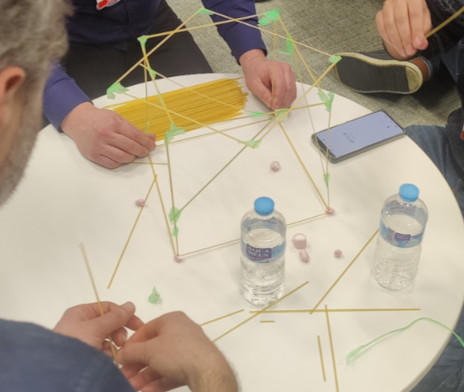A few days ago I had the pleasure of attending some meetings with the team, where we took the opportunity to perform some tasks beyond the scope of pure work. I faithfully believe that in any company or work team, it is essential to have a good group dynamics to achieve common goals. For this, it is important to know the team members well, to know what their strengths and weaknesses are, and to find the best way to work together. This will also help to create a fail-safe environment where people feel comfortable with each other. Team building exercises are a very useful tool to achieve all this and much more.

What is team building?
Looking around the Internet, we can find definitions of team building that talk about the set of techniques and activities that are used to improve communication, cooperation and cohesion of a work group. These activities are carried out with the aim of fostering teamwork, improving trust and empathy among members, and creating a positive and productive environment.
Examples of team building activities include role-playing games, group dynamics, outdoor activities and problem-solving workshops. Each of these activities has a specific objective and can be adapted to the needs of each team, but it is essential that they are fun and encourage people’s participation.
Team building is essential for any company or work team because it helps create a positive work environment, improves communication and collaboration among members, and increases productivity and efficiency.
When team members know each other well, they feel more comfortable and confident working together. This allows them to share ideas and solve problems more effectively and without as much fear of asking questions because of “what will they say?” or “what will they think of me?”, in other words, to create an environment where (LINK to fail environment) they can fail. In addition, when they feel part of a united team, they are more committed to the company’s objectives and strive to achieve them together.

On the other hand, team building exercises also help to identify the strengths and weaknesses of each team member as well as their desires and fears. This allows tasks and responsibilities to be assigned more effectively, and can also help develop skills and competencies that can be useful in day-to-day work.
How to conduct effective team building exercises?
For team building exercises to be effective, I have always heard the same recommendations and I can endorse them:
- Tailor the activity to the needs of the team: not all team building activities are suitable for all teams. It is important to adapt the activity to the needs and characteristics of the team, and also consider factors such as age, gender and culture.
- Encourage participation: For team building exercises to be effective, it is essential that all team members actively participate. It is important to ensure that everyone feels comfortable and motivated to participate.
- Evaluate the results: Depending on the activity carried out and the objective pursued, it is advisable to evaluate the results. This will allow to identify what worked well and what can be improved in the future and to get to know better the personality of each participant.
Examples of team building exercises
If we search the Internet, we will find plenty of exercises for team building, and as we have advised above, it is good to adapt it to the needs of each team. Some examples of exercises could be:
- Spaghetti tower: Although we were told as children that we should not play with food, this exercise is one of my favorites. In it we can see the role that each person takes in the team, how each one thinks out of the box, and how they are organized among themselves taking into account the time. The exercise consists of several groups in which the members of each team have to build a tower using only dry spaghetti, tape and one or two marshmallows. This exercise encourages collaboration, creativity and problem solving.
- Role Play: In this exercise, team members divide into groups and act out different roles in a specific work situation. This encourages communication, empathy and understanding of different perspectives. One drawback I have encountered is that someone may feel offended when they act out their role in a humorous way.
- Escape room: This exercise is usually done with the help of companies that are dedicated to it. Team members have to work together to solve a series of puzzles and escape from a room in a set amount of time. This exercise encourages collaboration, problem solving and decision making.
- Trust dynamic: In this dynamic, team members have to trust their teammates to guide them with their eyes closed through a maze. This encourages trust, communication and cooperation.

Will it help us to get to know the team well?
Team building dynamics serve above all to build trust between the people in the team, to really form a cohesive and confident team and not a “gang working in the same company”. From team building dynamics we can obtain some knowledge of each person in the team, but to know them well, it is essential to establish a work environment in which communication and trust are fostered. Some examples of strategies that can help would be:
- Organize regular meetings: Regular meetings allow team members to catch up on project news and progress, and can also be a space to discuss ideas and solve problems.
- Establish common goals: When all team members have a common goal, they are more motivated to work together to achieve it. In addition, this aligns individual efforts with the company’s goals.
- Encourage open communication: It is important that team members feel comfortable sharing their ideas and opinions. To do this, it is necessary to foster an environment of respect and trust, where everyone’s opinions are valued.
- Promote collaboration: Collaboration is fundamental to teamwork. It is important that team members feel comfortable working together and are willing to help each other when needed.
- Know each member’s strengths and weaknesses: To effectively assign tasks and responsibilities, it is important to know the strengths and weaknesses of each team member. This can be done through one-on-one conversations, performance evaluations and team building exercises. Knowing desires and concerns: Knowing what each team member expects, what they want to do and what they don’t want to do, knowing their intrinsic motivators helps to assign tasks aligned to each person’s desires, avoiding “rewarding” someone with something that may actually be perceived as a “punishment” or something “uncomfortable”.
Knowing the team well and performing team building exercises are fundamental for the success of any company or work team. These activities encourage communication, cooperation and group cohesion, and also help to identify the strengths and weaknesses of each member, improving the productivity and efficiency of the team and above all remember that before workers, we are all people.
I love the idea of reflecting on a team like this. Deep appreciation and storytelling bring richness to team building that goes beyond tasks. What inspired this post?
We are all aware of the positive effect that team building activities have. Specifically, I thought of writing this post when I saw how the morale of my team (99% of whom work remotely around the world) went up drastically after doing a face-to-face teambuilding, and the interpersonal relationships facilitated conversations that did not happen before.